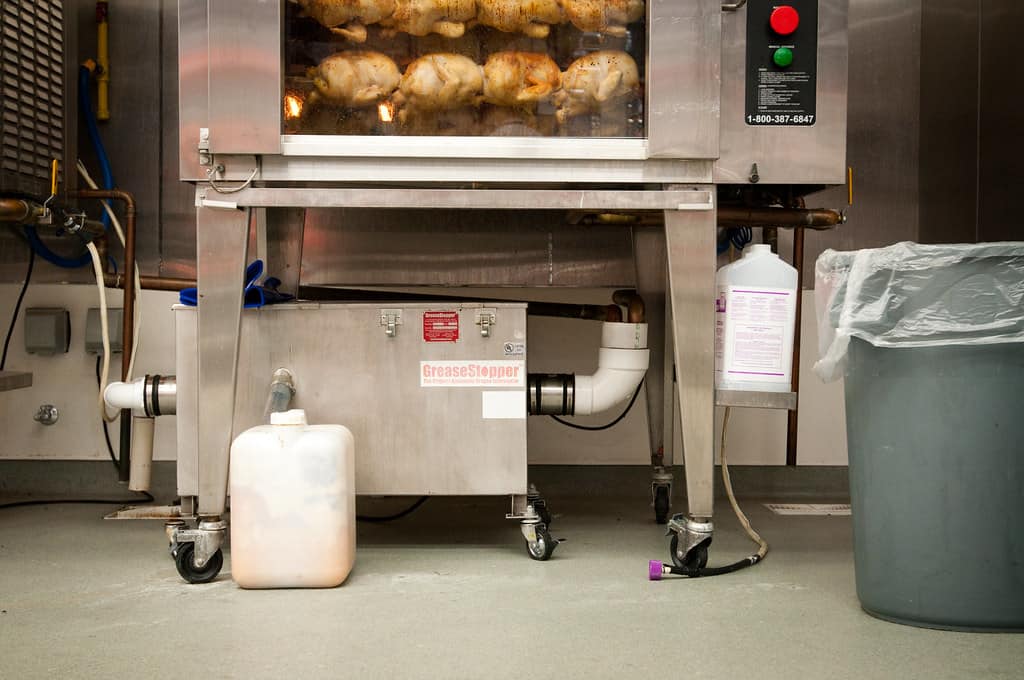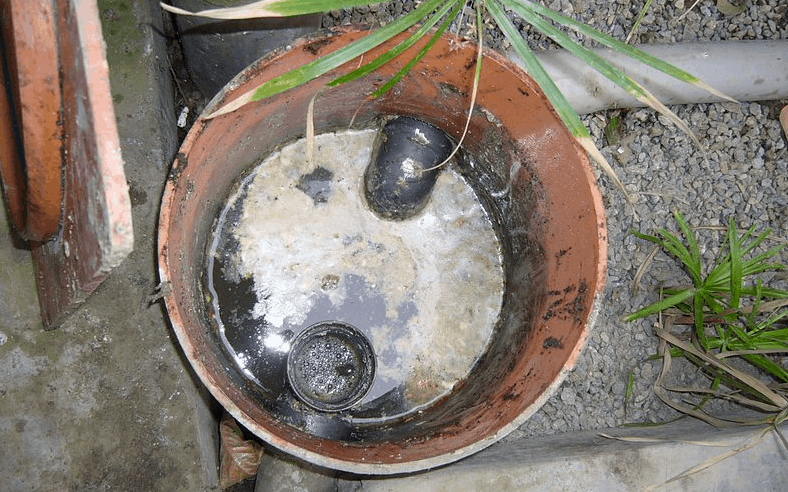- Best Chefs Choice Meat Slicers Model Guide - November 3, 2021
- Turbochef Pizza Oven Review: Is It The Best Possible Pick For Your Resturant? - September 10, 2021
- Best Southbend Range Guide For Finding The Perfect Option For Your Commercial Kitchen - September 4, 2021
Well, if you arrive one Monday morning at your restaurant and a horrible smell great you as you open the door, you know: GREASE TRAP overflowing. You forgot to call the specialists to test and clean it. Now you sit with the mess, and you must try and do this absolutely awful job yourself, but how? You have no clue where the grease trap is. Where is this grease trap situated, you have never done this job before, how does one clean a grease trap? You want help.
First off, why is that the Grease Trap is so important? It keeps grease, oils, and other fats out of the public sewer works, not only for public health reasons more importantly it stops the inspector to administer a fine or even close you down.
A monthly maintenance plan won’t only help the environment, but a blocked facility can become costly with repairs, chaos at the back of the house, and possible lost revenue. All thanks to non-existent or bad management.
Grease Traps Cleaning Guide: How Does It Work?

Grease Traps do exactly that, they trap fatty oils grease, and sludge and separate that muck from water. The hot substance from your sink passes through a catching system to chill and solidify. The water carries on through the drain as normal. Fats, oil, and grease are lighter than water therefore it floats.
Solids like food go all the way down to the bottom. Now if you permit the trap to be unattended and it fills up, already if it’s only 25% full, over 60% of the fats, oil, and grease go down the drain into the sewer system.
The proportion does increase the fuller the trap becomes. It’s therefore important to keep the trap clean. The easy way in this situation would be to call a specialist to clean up, but there is nobody available and you have to do the job,
Things You’ll Need
- A Mask
- Pry bar
- Wooden dowel or stick
- Tape measure
- Pump out report
- Bucket
- Wet/dry vacuum (optional)
- Liquid soap
- Steel pot scrubber
- Water source
Where Are Grease Traps Located?

Most of the time grease traps are inside the building and under the sink. They are sorted into metal boxes that usually range from 10 gallons (40 l) to 50 gallons. (200 l) Grease traps are also often used on individual sink units.
Commercial grease traps are typically located outside of your main building. Check outside, buried inside the ground near the walls by your kitchen’s dishwashing station. Look for a manhole or a septic tank cover. If your commercial kitchen has a basement below, you will also find your grease trap down there looking like a big tank. Or they’ll be inside the building and under the sink.
How to Clean Your Grease Trap
There are several ways how to clean a grease trap, it depends on the size, location, and type of grease trap. You can do it manually by yourself or call a professional company. In an emergency like now, you must do the job and get dirty. Yes, you should have set a weekly or monthly grease trap maintenance schedule, stick to it so that your establishment will always run safely and efficiently.
Of course, the best time to clean will be If you can wait until your restaurant is closed for the day. Or you can also consider cleaning your grease trap early in the morning before you begin your opening procedures. Sometimes like now you will have no option it will need to be done NOW! If you have to do it yourself it’s important to follow these steps for the most effective results:
- Remove the lid from the grease trap. Remove it slowly and gently, so you do not damage any of the gaskets on the lid.
- Stick a ruler into the grease trap and note how many inches of grease is in the trap. This needs to be written down and recorded in a FOG report provided by the EPA.
- Remove the water from your grease trap, either with a bucket or a small pump. Set this water aside.
- Start scooping out the grease from your trap. You’ll use another bucket, a shovel or other heavy-duty scooper.
- Scrape the bottom, sides, and lid to get rid of any excess grease. It is important that all of the grease and fat will be removed this will help to prevent quick build-ups from debris you have knocked loose but have not removed.
- Scrub the identical parts of your trap and flush the screens out.
- Pour the water from Step 3 back into your grease trap.
- Properly reinstall any removed parts and replace the lid.
Tips
- A mask is suggested due to the rancid odors of the grease trap.
- For optimal results, you should perform a vigorous cleaning a minimum requirement for every 90 days. This will be minimizing foul odors emanating from the trap, preventing it from overflowing into your business or the street, and guaranteeing its effectiveness.
- There are many alternative methods available for the disposal of grease trap waste. Instead to merely throw the debris into the garbage, which goes to a dump, consider available alternatives, there are companies that recycle the waste into usable biofuel.
- Never ever use a grease trap additive, including bacteria or enzymes. These products will improve the odor but will push the grease from the trap into the sanitary sewer. The grease will in time re-harden and causes severe grease blockages.
Signs Your Restaurant’s Regular Grease Trap Needs Cleaning
- So, if you notice that it’s becoming a bit more difficult for water to drain down your drainage system, you’ll want to get your grease trap and drains cleaned ASAP
- Best practices dictate that grease trap cleaning should be done at least once every three months. However, if you run a busy restaurant, you may have to clean it more frequently, even once every month.
- the presence of grease around your kitchen is often an indication that your trap needs to be cleaned.
You might be wondering, “how could that possibly happen”? Well, if your grease trap clogs, the extra grease may be forced to escape through the easiest exits. That will include sinks, sewer pipes, water lines, and so on. And when that happens, you’ll have grease in every wrong place.
Therefore, if you notice these signs, you ought to check whether your grease trap is the cause. If it is, then you’ll want to clean it; as well as any place where grease deposits are found.
Is It Time For a Replacement?
One of the most effective ways to understand if it’s time to replace your grease trap is when your local municipality requests an inspection because grease is leaking into the local water system — if possible, you must maintain your grease trap before it gets this bad. You must also consider replacing the system if it constantly backs up, stops filtering grease out of your water, becomes too hard to clean or causes smells in your kitchen.
FAQs
Question: Does a landlord pay for cleaning grease traps if the renter is not in business yet?
Answer: The landlord is responsible for ensuring the cleanliness and odorless nature of the grease trap before the renter accepts the unit. So, in this case, the landlord must pay since you have not yet used it.
Question: Why is the area around my grease trap flooded?
Answer: The lid might not be on properly, or there may be possible corrosion below the trap. You ought to check all the screws to make sure everything is tightened properly.
Question: How do I remove a nasty odor?
Answer: If you have recently serviced your grease trap or your grease interceptor and are still experiencing a horrific odor, you may have ventilation issues. I would suggest you check the seals, ventilation, or plumbing to make certain there are no issues with it.
Unexplainable odors are often a clear indicator of a grease trap that needs cleaning. These are the smells that do not disappear, even after you’re taking out the garbage and clean your commercial kitchen.
Question: Why are there cockroaches on my grease trap? The lid is on securely.
Answer: Talk to a licensed plumber about possibly installing a brand new one or new pipes. It might be corroded and allowing bugs into your system.
Question: Can I pour bleach down the grease trap?
Answer: I would not suggest doing this. If bleach is added to a grease trap, it will temporarily relieve odor issues. Unfortunately, the odor will soon return because the root cause of the odor has not been addressed. The addition of bleach to an acidic environment can cause the grease to harden and form a crust further down the line. If this happens in the municipal lines, you may face fines due to the line maintenance they need to perform. If the build-up occurs in your private lines, you will have to front the money to have a plumber address the build-up. Not to mention, there is always the possibility of causing your personal lines to overflow back into the restaurant.
Grease Trap Cleaning Guide: Conclusion
Grease traps are amazing tools that help keep your establishment smelling great, so your customers keep coming back. They can also be the biggest annoyance that restaurants face, especially if you forget to clean them on a regular basis.
Proper grease trap maintenance can keep your restaurant running smoothly, and commercial plumbing service can ensure you don’t get any of the smelly, expensive backups that occur when you don’t catch the fats, oils, and grease before they entire your sewer line.
Generally, keeping your grease traps in good health is beneficial to you. You won’t need to worry about bad odors or risking your employees/clients’ health. In summary, don’t take any chances. Ensure you clean your grease traps at least once every three months or earlier, do so properly. If not, fats, oils, and grease will begin to accumulate.
If you don’t have the required tools or skills, you will need additional help! Consider hiring an expert grease trap cleaning company’s services from your area to do this nasty job for you.
So, when did you thoroughly clean your grease traps last?

